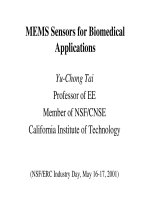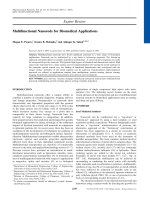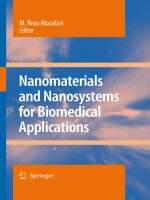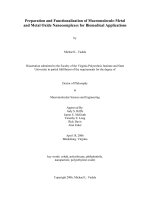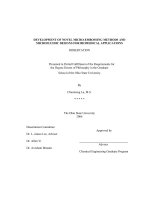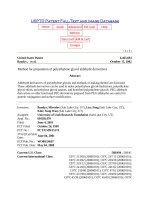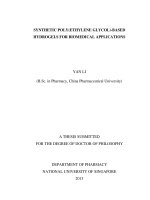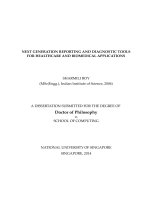Synthetic poly(ethylene glycol) based hydrogels for biomedical applications
Bạn đang xem bản rút gọn của tài liệu. Xem và tải ngay bản đầy đủ của tài liệu tại đây (1.86 MB, 149 trang )
SYNTHETIC POLY(ETHYLENE GLYCOL)-BASED
HYDROGELS FOR BIOMEDICAL APPLICATIONS
YAN LI
(B.Sc. in Pharmacy, China Pharmaceutical University)
A THESIS SUBMITTED
FOR THE DEGREE OF DOCTOR OF PHILOSOPHY
DEPARTMENT OF PHARMACY
NATIONAL UNIVERSITY OF SINGAPORE
2013
DECLARATION
I hereby declare that the thesis is my original work and it has been written by me in its
entirety. I have duly acknowledged all the sources of information which have been used
in the thesis. This thesis has also not been submitted for any degree in any university
previously.
.
Yan Li
25 Dec 2012
i
ACKNOWLEDGEMENT
I would like to express my sincerest gratitude to my supervisors, Dr. Ee Pui Lai Rachel
and Dr. Yi-Yan Yang for their patience, guidance and support over the course of this
research. They are constant inspirations and their suggestions were invaluable towards
the completion of this work. I would also like to thank our collaborator Dr James L.
Hedrick from the IBM Almaden Research Centre for the inspiring discussions and his
invaluable contributions to our research.
I would like to acknowledge the Department of Pharmacy at the National University of
Singapore and the Institute of Bioengineering and Nanotechnology (IBN), A*STAR for
the various opportunities that have helped to make this journey an educational as well as
an enjoyable one.
I would like to thank all past and present members of the Drug and Gene Delivery Group
at IBN, A*STAR, especially: Ms Amalina Bte Ebrahim Attia, Dr Ashlynn Lee, Ms
Cheng Wei, Mr Chin Willy, Mr Ding Xin, Dr Gao Shujun, Dr Jeremy Tan, Mr Ke Xiyu,
Dr Liu Lihong, Dr Liu Shao Qiong, Dr Majad Khan, Dr Nikken Wiradharma, Dr Ng
Victor, Dr Ong Zhan Yuin, Ms Qiao Yuan, Ms Sangeetha Krishnamurthy, Dr Shrinivas
Venkataraman, Ms Teo Pei Yun, Mr Voo Zhi Xiang, Dr Wu Hong, Dr Yang Chuan, Ms
Yong Lin Kin and Ms Zhang Ying for their helpful discussion, sharing of knowledge and
most importantly their constant encouragement throughout the years. Special thanks go to
all past and present members of Dr. Ee’s research lab in the Department of Pharmacy,
ii
especially to Dr Leow Pay Chin, Dr Tian Quan, Miss Luqi Zhang, Miss Bahety Priti
Baldeodas, Miss Ying Wang and Mr Jasmeet Singh Khara for their kind help and advice.
I would like to dedicate this research work to my family. To my parents, who have
always encouraged me to pursue my dreams and never give up. From them I have learned
to be the best that I can be. To my brother, who is my guide and greatest friend. Last but
not least, I would like to thank all my friends in Singapore and worldwide for their
constant friendship and company during my graduate studies.
iii
LIST OF PUBLICATIONS AND PRESENTATIONS
Publications:
Yan Li, Chuan Yang, Majad Khan, Shaoqiong Liu, James L. Hedrick, Yiyan Yang and
Pui Lai Rachel Ee, Nanostructured PEG-Based Hydrogels with Tunable Physical
Properties for Gene Delivery to Human Mesenchymal Stem Cells, Biomaterials 2012
33(27):6533-41
Yan Li, Kazuki Fukushima, Amanda Engler, Daniel J. Coady, Shaoqiong Liu, Yuan
Huang, John S.Cho, Yi Guo, Lloyd S. Miller, Pui Lai Rachel Ee, Weimin Fan, Yi Yan
Yang and James Hedrick, Broad-spectrum antimicrobial and biofilm disrupting hydrogels:
stereocomplex-driven supramolecular assemblies, Angewandte Chemie International
Edition 2012 52(2):674-8
Shao Qiong Liu, Chuan Yang, Yuan Huang, Xin Ding, Yan Li, Wei Min Fan, James L.
Hedrick, and Yi-Yan Yang, Antimicrobial and Antifouling Hydrogels Formed In
Situ from Polycarbonate and Poly(ethylene glycol) via Michael Addition, Advanced
Materials, 2012 24(48):6484-9
Conference presentations
Yan Li, Chuan Yang, Shaoqiong Liu, Pui Lai Rachel Ee, James L. Hedrick and Yi-Yan
Yang, Nanostructured synthetic hydrogels as scaffolds for cell delivery, The 5th SBE
International Conference on Bioengineering and Nanotechnology (ICBN) 2010, 1-4 Aug
2010, Singapore. Poster presentation.
Yan Li, Chuan Yang, Majad Khan, Shaoqiong Liu, Pui Lai Rachel Ee, James L. Hedrick
and Yi-Yan Yang, Nanostructured synthetic hydrogels as scaffolds for cell and gene
delivery, Material Research Society Fall Meeting & Exhibit (MRS) 2011, 28 Nov-2 Dec
2011, USA. Oral Presentation.
Yan Li, Pui Lai Rachel Ee, James L. Hedrick and Yi-Yan Yang, Stereocomplex hydrogel
with supramolecular structures for vancomycin delivery to treat MRSA-induced skin
infection, European Material Research Society (EMRS) 2012 Fall Meeting, 17-20 Sep
2012, Poland. Oral Presentation.
iv
TABLE OF CONTENTS
SUMMARY vii
List of Tables x
List of Schemes xi
List of Figures xii
List of Abbreviations xvii
CHAPTER 1. INTRODUCTION 1
1.1 What are hydrogels? 1
1.2 Materials of hydrogels 2
1.3 Preparation methods of PEG hydrogels 4
1.4 Physical properties of hydrogels 7
1.5 Biomedical applications of hydrogels 8
1.5.1 Tissue engineering 9
1.5.1.1 Cell sources 9
1.5.1.2 Scaffolds 10
1.5.1.3 Bioactive cues 12
1.5.2 Antimicrobial applications 13
1.5.2.1 Antimicrobial agents 14
1.5.2.2 Antimicrobial mechanisms 16
1.5.2.3 Antimicrobial hydrogels 18
CHAPTER 2. HYPOTHESIS AND AIMS 22
CHAPTER 3. NANOSTRUCTURED PEG-BASED HYDROGELS WITH
TUNABLE PHYSICAL PROPERTIES FOR GENE DELIVERY 26
3.1 Background 26
3.2 Material and Methods 29
3.2.1 Materials 29
3.2.2 Synthesis of VS-PEG-PC polymer 30
3.2.3 Micelle formation and characterization 30
3.2.4 Synthesis of micelles-containing PEG hydrogels 31
3.2.5 Physical characterization of hydrogels 31
3.2.6 Culture and encapsulation of hMSCs in the hydrogels 32
3.2.7 Cell viability in the hydrogels 33
3.2.8 Characterization of polymer/DNA complex 34
3.2.9 Gene transfection in 2D cell culture plate 34
3.2.10 Cytotoxicity studies of polymer/DNA complex in 2D cell culture plate 35
3.2.11 Gene transfection in 3D hydrogels with different micelle content 35
3.2.12 Cytotoxicity studies of polymer/DNA complex in 3D hydrogels 36
3.2.13 Statistical analysis 37
3.3 Results and discussion 37
3.3.1 Synthesis of VS-PEG-PC polymer 37
3.3.2 Micelle formation and characterization 38
3.3.3 Synthesis and physical characterization of micelle-containing hydrogels 40
3.3.4 Cell viability in the hydrogels 44
3.3.5 Characterization of polymer/DNA complex 46
3.3.6 Transfection efficiency in 2D cell culture plate 49
v
3.3.7 Cytotoxicity of polymer/DNA complex in 2D cell culture plate 49
3.3.8 Transfection efficiency in 3D hydrogels with different micelle content 51
3.3.9 Cytotoxicity of polymer/DNA complex in 3D hydrogels 53
3.4 Conclusion 54
CHAPTER 4. STEREOCOMPLEX HYDROGEL WITH SUPRAMOLECULAR
STRUCTURES FOR ANTIMICROBIAL AND ANTIBIOFILM ACTIVITIES56
4.1 Background 56
4.2 Materials and methods 61
4.2.1 Materials 61
4.2.2 Polymer synthesis and characterization 62
4.2.2.1 Polymer synthesis 62
4.2.2.2 Particle size and zeta potential 62
4.2.2.3 Minimal inhibitory concentration (MIC) determination 62
4.2.2.4 Hemolysis assays 63
4.2.2.5 Cytotoxicity assay 63
4.2.3 Hydrogel formation and characterization 64
4.2.3.1 Hydrogel formation 64
4.2.3.2 Differential scanning calorimetry 64
4.2.3.3 X-ray diffraction analysis 65
4.2.3.4 Rheology 65
4.2.3.5 Fiber observation under optical microscopy, SEM, TEM 65
4.2.4 Antimicrobial activities in vitro 66
4.2.4.1 Killing efficiency 67
4.2.4.2 SEM observation 67
4.2.4.3 Drug resistance stimulation study 68
4.2.5 Antibiofilm activities in vitro 68
4.2.5.1 Biofilm growth on 96 well plate 68
4.2.5.2 Biomass assay 69
4.2.5.3 XTT assay 69
4.2.5.4 SEM observation 70
4.2.6 Antibiofilm activities in vivo 70
4.2.6.1 Contact lens-associated keratitis model 70
4.2.6.2 Biofilm susceptibility 72
4.2.7 Statistical analysis 73
4.3 Results and discussions 73
4.3.1 Polymer synthesis and characterization 73
4.3.1.1 Polymer synthesis 73
4.3.1.2 Particle size and zeta potential 74
4.3.1.3 Minimal inhibitory concentration (MIC) determination 75
4.3.1.4 Hemolysis and cytotoxicity assays 76
4.3.2 Hydrogel formation and characterization 77
4.3.2.1 Hydrogel formation 77
4.3.2.2 Differential scanning calorimetry 78
4.3.2.3 X-ray diffraction analysis 79
4.3.2.4 Rheology 80
4.3.2.5 Fiber observation under light microscope, SEM and TEM 83
vi
4.3.3 Antimicrobial activities in vitro 86
4.3.3.1 Killing efficiency 86
4.3.3.2 Antimicrobial mechanism 88
4.3.3.2 Drug resistance stimulation study 90
4.3.4 Antibiofilm activities in vitro 91
4.3.4.1 Biomass and XTT assay 91
4.3.4.2 SEM observations 93
4.3.5 Antibiofilm activities in vivo 94
4.3.5.1 Fungal recovery assay 94
4.3.5.2 Histopathology 94
4.4 Conclusion 96
CHAPTER 5. CONCLUSION AND FUTURE PERSPECTIVES 98
5.1 Conclusion 98
5.2 Future perspectives 100
REFERENCES 104
APPENDICES 117
Appendix A: Synthetic procedures and molecular characterization of VS-PEG-CPC
and cationic bolaamphiphile 117
Appendix B: Synthetic procedures and molecular characterization of cationic
bolaamphiphile 123
Appendix C: Synthetic procedures and molecular characterization of P(D/L)LA-PEG-
P(D/L)LA and cationic polymer PDLA-CPC-PDLA 125
vii
SUMMARY
Synthetic poly(ethylene glycol) (PEG)-based hydrogels have been widely used as a
highly valuable class of biomaterials for various biomedical applications due to their
inherent biocompatibility, biochemical inertness and ease of meeting specific
requirements through functional tailoring. The overall goal of this thesis is to design,
develop and evaluate the application of synthetic PEG-based hydrogels in two different
biomedical applications: tissue engineering and antimicrobial therapeutics.
In tissue engineering, we hypothesized that genetic manipulations of human
mesenchymal stem cells (hMSCs) in a nanostructured hydrogel microenvironment will
provide an effective approach to improve cell delivery for tissue engineering.
To test our hypothesis, we explored two specific aims:
Aim 1: Synthesize and characterize injectable PEG hydrogels with micellar
nanostructures incorporated. Here we described the rationale of incorporating micellar
particles into PEG-based hydrogels with key features of tuning the physical properties of
the hydrogels such as swelling ratio, porosity and degradability. We successfully
demonstrated that the physical properties of the hydrogels could be tuned predictably and
thus enabled the subsequent study of biological interaction between the PEG-based
hydrogel scaffold and encapsulated cells.
viii
Aim 2: Evaluate cell viability and gene transfection efficiency of hMSCs
encapsulated in the nanostructured hydrogels. Here we further evaluated the hydrogel
scaffold for both cell survival and gene transfection. We demonstrated that our synthetic
bolaamphiphile was superior to poly(ethylenimine) (PEI) as non-viral gene carrier and
hydrogels with 20% micelle content provided the optimal microenvironment for both cell
survival and gene transfection. Therefore, incorporating micelles into hydrogels is a good
strategy to control cellular behavior in a three dimensional hydrogel environment for
tissue engineering.
For antimicrobial therapeutics, we hypothesized that hydrogels with cationic polymers
incorporated provide an excellent formulation for clinical use in eliminating various
microorganisms and biofilms.
To test our hypothesis, we explored three specific aims:
Aim 1: Synthesize and characterize cationic polymers for the formation of
stereocomplex PEG hydrogels with supramolecular structures. Here we first
described particle size and toxicity of the three cationic polymers followed by the
evaluation of physical properties of the cationic polymer incorporated hydrogel including
stereocomplex formation, stiffness and supramolecular structures. It was demonstrated
that polymer with optimal hydrophobic/hydrophilic balance was the least toxic and
cationic polymer containing hydrogel formed through stereocomplexation with shear-
thing property and ribbon-like supramolecular structure were observed.
ix
Aim 2: Evaluate the antimicrobial and antibiofilm activities of the hydrogel with
cationic polymer incorporated in vitro. Here we evaluated the antimicrobial and
antibiofilm activities of the hydrogel with different amount of cationic polymer
incorporated in vitro. We showed that these hydrogels exhibited broad spectrum
antimicrobial activities against both Gram-positive and Gram-negative bacteria, fungus
and various clinically isolated drug-resistant pathogens. Moreover, they were capable of
dispersing biofilms formed by S. aureus, methicillin resistant S. aureus, E. coli and C.
candida. The mechanism of antimicrobial and antibiofilm action was found to be through
the physical disruption of the bacterial cell membrane.
Aim 3: Investigate the in vivo activity of our hydrogel using the fungal keratitis
animal model. Here we tested the antibiofilm activity of the hydrogel on the fungal
keratitis animal model in vivo. It was demonstrated that our hydrogels were comparable
or superior to commercially available antibiotics Amphotericin B, evidenced by the
significant decrease in fungal recovery and hyphae invasion without any display of
toxicity in healthy eyes. Therefore, these cationic hydrogels showed great potential for
clinic use in eliminating various microorganisms and biofilm infections.
In conclusion, the findings of this thesis supported the hypothesis specified in each
application and well-defined synthetic PEG-based hydrogels served as a promising
platform in meeting the specific requirements in our intended applications in tissue
engineering and antimicrobial therapeutics.
x
List of Tables
Table 3.1 Physical properties of hydrogels.
Table 4.1 Minimum inhibitory concentrations (MICs) of cationic PDLA-CPC-PDLA
triblock copolymers. The MICs of the polymers were measured using a
broth microdilution method.
xi
List of Schemes
Scheme 3.1 Synthetic scheme of micelle-containing peptide/PEG hydrogel. VS-PEG-
PC micelles were formed in advance by dissolving the polymer directly in
0.3M triethanolamine buffer (pH 8.0) and stabilized overnight before
adding to the hydrogel precursor solution. RGD peptide was chemically
built into the hydrogel networks for cell adhesion. Gelation was done in
37 °C incubator. Chemical structure of Vinyl sulfone-PEG-b-
polycarbonate.
Scheme 3.2 Chemical structure of bolaamphiphile (MK397).
Scheme 4.1 Chemical structure of P(D/L)LA-PEG-P(D/L)LA. Three separate PDLA-
CPC-PDLA polymer compositions of different block length were
synthesized; 1000-6000-1000 (PC1), 2000-13000-2000 (PC2) and 1500-
6000-1500 (PC3).
Scheme 4.2 Chemical structures of PLLA-PEG-PLLA and PDLA-CPC-PDLA (a) and
pictures of 10 wt% solution at 25 ºC (b) and at 37 ºC (c). At 25 ºC the
solution is clear fluid and each polymer forms flower-type micelles in
aqueous environment (d). Upon heating at 37 ºC for 30 min, the solution
turns into opaque gel based on stereocomplex formation between
enantiomeric pure polylactide segments in the micelle cores (e).
Scheme A.1 Synthetic schemes of VS-PEG-polycarbonate.
Scheme C.1 Typical synthesis of polylactide-b-poly(ethylene glycol)-b-polylactide
(PLA-PEG-PLA) triblock copolymer.
Scheme C.2 Typical preparation of poly(D-lactide)-b-cationic poly(carbonate)-b-
poly(D-lactide) (PDLA-CPC-PDLA) triblock copolymers.
xii
List of Figures
Figure 1.1 Synthesis scheme for the stepwise copolymerization of biomolecules
containing free thiols on Cys residues with end-functionalized PEG
macromers bearing conjugated unsaturated moieties.
Figure 1.2 Comparison in functional mechanism between small molecular antibiotics
and macromolecular antimicrobials. (a) Mechanisms of antibiotic
resistance in bacteria and (b) mechanism of membrane-active
antimicrobial peptides.
Figure 1.3 Diagram showing the development of a biofilm as a five-stage process.
Stage 1: initial attachment of cells to the surface. Stage 2: production of
EPS resulting in more firmly adhered “irreversible” attachment. Stage 3:
early development of biofilm architecture. Stage 4: maturation of biofilm
architecture. Stage 5: dispersion of single cells from the biofilm. The
bottom panels (a-e) show each of the five stages of development
represented by a photomicrograph of P. aeruginosa when grown under
continuous-flow conditions on a glass substratum.
Figure 3.1 Determination of critical micelle concentration (CMC) of VS-PEG-
polycarbonate. VS-PEG-PC micelles were formed and stabilized
overnight before measurement.
Figure 3.2 A typical TEM image of micelles prepared using VS-PEG-PC in DI water
with polymer concentration of 0.5 mg/mL. Scale bar: 50 nm.
Figure 3.3 Effects of micelle content on the swelling ratio of the hydrogels. The
hydrogels were placed in PBS buffer at 37 C for 24 hours, swelling ratio
was calculated from the formula: Swelling ratio = (W
w
-W
d
)/W
d
, where
W
w
represents the weight of swollen gels, W
d
represents the weight of the
freeze-dried gels. All samples were analyzed in triplicate.
Figure 3.4 A typical SEM image of cross-sectioned hydrogel with different contents
of micelles. The hydrogels were immediately frozen in liquid nitrogen
prior to freeze drying to keep the morphology intact. (A) 0%, (B) 20%, (C)
40%, (D) 60% and (E) 80%. Scale bar: 10μm.
Figure 3.5 Storage modulus (Ge) of the hydrogel with 20% micelles changes as a
function of time for 28 days. Hydrogels were incubated in PBS in 37 °C
incubator and rheology measurement was carried out periodically.
xiii
Figure 3.6 Effect of the micelle content on the viability of hMSCs in the hydrogel.
hMSCs were incubated in the hydrogel for 4 days. MTT test was carried
out by adding MTT solution to the hydrogel and incubating for 4 hours.
The hydrogel constructs were then collected and homogenized with tissue
ruptor. Aliquots of the solution were then assayed with a microplate
reader. The results were expressed as a percentage of the cell viability in
the hydrogel without the micelles.
Figure 3.7 Confocal images of hMSCs incorporated in the hydrogels with different
contents of micelle. LIVE/DEAD viability/cytotoxicity kit was used to
stain hMSC in the hydrogels (A) 0%, (B) 20%, (C) 40%, (D) 60% and (E)
80%. Scale bar: 50 μm. Green represent live cells and red represents dead
cells.
Figure 3.8 Particle size and zeta potential of bolaamphiphile/DNA complex.
Polymer/DNA complexes were formed by adding different volume of
polymer solution into an identical volume of reporter gene solution at
different N/P ratios.
Figure 3.9 Electrophoretic mobility of DNA in bolaamphiphile/DNA complexes at
N/P ratios specified. Lane 1: naked DNA; last lane: blank polymer.
Cationic bolaamphiphile/DNA complexes were prepared and
electrophoresed with various N/P ratios ranging from 2 to 14. The gel was
then analyzed on a UV to show the position of the complexed DNA
relative to that of naked DNA.
Figure 3.10 Gene transfection of bolaamphiphile/DNA complex in 2D cell culture
plate. Complex solution was added into fresh media at various N/P ratios
and incubated for 4 hours. hMSC were further cultured for 4 days before
carrying out the reporter gene analysis.
Figure 3.11 Cytotoxicity studies of bolaamphiphile/DNA complex in 2D cell culture
plate. Complex solution was added into fresh media at various N/P ratios
and incubated for 4 hours. hMSC were further cultured for 4 days before
carrying out the cell viability analysis by MTT assay.
Figure 3.12 Luciferase expression level in the hMSCs incorporated in the hydrogels
with and without 20% micelles. hMSCs mixed with complex solution at
various N/P ratios were added into hydrogels and incubated for 4 hours.
The hydrogel constructs were further cultured for 4 days before carrying
out the reporter gene analysis.
Figure 3.13 Luciferase expression level in the hMSCs incorporated in the hydrogels
with different micelle content. hMSCs mixed with complex solution at
N/P ratio 7.5 were added into hydrogels and incubated for 4 hours. The
xiv
hydrogel constructs were further cultured for 4 days before carrying out
the reporter gene analysis.
Figure 3.14 Viability of hMSCs in the hydrogel after incubation with
bolaamphiphile/DNA and PEI/DNA for 4 days at various N/P ratios
specified. hMSCs mixed with complex solution at various N/P ratios were
added into hydrogels and incubated for 4 hours. The hydrogel constructs
were further cultured for 4 days before carrying out the cell viability
analysis using MTT assay.
Figure 4.1 Particle size and zeta potential of cationic polycarbonate copolymers
PDLA-PC-PDLA. Polymer solutions were prepared in DI water at 1
mg/ml using PDLA-CPC-PDLA and equilibrated for 1 hour before
measurement.
Figure 4.2 Hemolytic activities of cationic polycarbonate copolymers PDLA-PC-
PDLA. Fresh mouse red blood cells were incubated with polymer
solution for 1 hour. The red blood cell suspension in PBS was used as
negative control.
Figure 4.3 Viability of primary human dermal fibroblasts after incubation with
cationic polycarbonate copolymers PDLA-PC-PDLA at various
concentrations for 12 hours.
Figure 4.4 Transmittance of PLLA-PEG-PLLA (850Da-6000Da-850Da), PDLA-
PEG-PDLA (1000Da-6000Da-1000Da) and their stereocomplexes in
water. Polymer concentration: 5 mg/mL.
Figure 4.5 Wide-angle X-ray diffraction patterns of Control Gel (PLLA-PEG-PLLA
and PDLA-PEG-PDLA at 1:1 molar ratio), Gel 1 (PLLA-PEG-PLLA,
(PDLA-PC-PDLA and PDLA-PEG-PDLA at 1:0.15:0.85), Gel 2 (PLLA-
PEG-PLLA, PDLA-PC-PDLA and PDLA-PEG-PDLA at 1:0.3:0.7) and
Gel 3 (PLLA-PEG-PLLA and PDLA-PC-PDLA at 1:1). The gels were
formed at 7%w/v and freeze dried for experiment.
Figure 4.6 Storage modulus of individual polymer solutions and stereocomplex gels.
Polymer concentration: 13.2% w/v. The dynamic storage modulus (G)
was examined as a function of frequency from 0.1 to 50 rad/s. The
measurements were carried out at strain amplitude (γ) of 5% to ensure the
linearity of viscoelasticity.
Figure 4.7 Rheology change of the cationic hydrogels as a function of annealing time.
Hydrogels were incubated in 37 ºC incubator and rheology of the
hydrogels was examined periodically at 1 hour, 5 hours and 24 hours.
xv
Figure 4.8 Viscosity of hydrogel as a function of sheer rate. Hydrogels were
incubated at 37 ºC incubator for 5 hours before the viscosity
measurements.
Figure 4.9 Optical micrographs of individual polymers and stereocomplex gels.
Polymer concentration: 7% w/v. Scale bar: 50 μm. Hydrogels were
diluted to 5 mg/ml for observation.
Figure 4.10 Fiber length of individual polymers and stereocomplex gels. Fiber length
was determined by counting and measuring 100 fibers at 5 different areas
of each sample.
Figure 4.11 SEM images of Control Gel (PLLA-PEG-PLLA and PDLA-PEG-PDLA
at 1:1 molar ratio), Gel 1 (PLLA-PEG-PLLA, (PDLA-PC-PDLA and
PDLA-PEG-PDLA at 1:0.15:0.85), Gel 2 (PLLA-PEG-PLLA, PDLA-
PC-PDLA and PDLA-PEG-PDLA at 1:0.3:0.7) and Gel 3 (PLLA-PEG-
PLLA and PDLA-PC-PDLA at 1:1).
Figure 4.12 TEM images of Control Gel (PLLA-PEG-PLLA and PDLA-PEG-PDLA
at 1:1 molar ratio), Gel 1 (PLLA-PEG-PLLA, (PDLA-PC-PDLA and
PDLA-PEG-PDLA at 1:0.15:0.85), Gel 2 (PLLA-PEG-PLLA, PDLA-
PC-PDLA and PDLA-PEG-PDLA at 1:0.3:0.7) and Gel 3 (PLLA-PEG-
PLLA and PDLA-PC-PDLA at 1:1).
Figure 4.13 Antimicrobial activities of cationic hydrogels against various microbes:
Growth inhibition of S. aureus (Gram-negative bacteria) E. coli (Gram-
negative bacteria) (b) and C. albicans (yeast) (c); % killing efficiency of
different microbes (Gel 1 for S. aureus and E. coli, Gel 2 for C. albicans).
The number of colony forming unit (CFU) was recovered and counted in
Killing efficiency= (cell count of control-survivor count on cationic
hydrogel)/cell count of control×100.
Figure 4.14 Killing efficiency of stereocomplex cationic hydrogels against various
clinically isolated microbes, including methicillinresistant S. aureus
(MRSA, gram-positive), vancomycinresistant enterococci (VRE, gram-
positive), P. aeruginosa (gram-negative), A. baumannii (gram-negative,
resistant to most antibiotics), K. pneumoniae (gram-negative, resistant to
carbapenem), and C. neoformans.
Figure 4.15 SEM images of S. aureus (a), E. coli (b) and C. albicans (c) before
(Control) and after incubation with Control Gel, Gel 1 (S. aureus and E.
coli), and Gel 2 (C. albicans) for 2 hours. Size of the bars: a,b-100 nm; c-
1 µm.
Figure 4.16 Changes in MIC against different antimicrobial agents upon repeated
exposure with sub-lethal concentration.E. coli was used as a model
microorganism and repeatedly exposed to antimicrobial agents at sub
xvi
MIC concentration. MIC of gentamicin, ciprofloxacin and cationic
hydrogels was monitored for consecutive 10 passages to monitor the MIC
changes.
Figure 4.17 Anti-biofilm activities of cationic hydrogels against various microbes:
biomass reduction (a1-3) and cell viability (b1-3) in S. aureus (1), MRSA
(2), E. coli (3) and C. albicans (4). Biofilms of different microorganisms
were formed for 7 days and treated with hydrogels for 24 hours. The
results were expressed as a percentage of the cell viability without
treatment.
Figure 4.18 SEM images of S. aureus (a), MRSA (b), E. coli (c) and C. albicans (d)
before (Control) and after incubation with Control gel, Gel 1 and Gel 2
for 24 hours. Size of the bars: 1 µm; inserted Control and Control gel
samples: 1 µm; inserted Gel 1 and Gel 2 samples: 100 nm.
Figure 4.19 Fungi recovery from cornea of all treatment groups (Control,
Amphotericin B and gel 3). Data normalized to control group. Fungus
were recovered from the eye ball and incubated at 22 ºC for 48 hours
before counting the colony forming unit (CFU). The number of CFU
revived was expressed as the number of CFU per cornea to determine the
survival of Candida albicans as compare to control group.
Figure 4.20 Typical clinical presentation of C. albicans keratitis mice eyes treated
with control, Amphotericin B and gel 3. A. Keratitis before treatment; B.
Keratitis after being treated with different groups hourly for 8 hours.
Figure 4.21 Histology of treated and healthy corneas treated with control,
Amphotericin B and gel 3. Antibiofilm activity and selectivity were
shown in A. Keratitis after being treated with control gel, AMB and
cationic gel 3; Safety of the hydrogel was tested on health eye treated
with control gel, AMB and cationic gel 3 (B).
Figure A.1 GPC diagram of VS-PEG-PC (Mn = 10,120, Mw/Mn = 1.12).
Figure A.2 Characterization of VS-PEG-OH, VS-PEG-polycarbonate (VS-PEG-PC)
and its self-assemblies: 1H NMR spectra of (A) VS-PEG-OH and (B) VS-
PEG-PC in CDCl3; (C) GPC diagram of VS-PEG-PC (Mn = 10,120,
Mw/Mn = 1.12).
xvii
List of Abbreviations
AMP Antimicrobial peptide
BCA Bicinchoninic acid
CMC Critical micelle concentration
CFU Colony forming unit
DMEM Dulbecco’s Modified Eagle Medium
DMSO Dimethyl sulfoxide
DS Differential scanning calorimetry
ECM Extracellular matrices
ESC Embryonic stem cell
EPL-MA Epsilon-poly-L-lysine-graft-methacrylamide
FBS Fetal bovine serum
HA Hyaluronic acid
HDF Human dermal fibroblast
HDP Host defense peptides
hMSCs Human mesenchymal stem cells
iPSC Induced pluripotent stem cell
LCST Low Critical Solution Temperature
MIC Minimum inhibitory concentration
MRSA Methicillin-resistant Staphylcoccus aureus
MSCGM Mesenchymal stem cell growth medium
PBS Phosphate buffered saline
P(D,L)LA Poly(D, L-lactide)
PDLA-CPC-PDLA Poly(D-lactide)-charged polycarbonate- poly(D-lactide)
PEC Polyelectrolyte complex
PEG Poly(ethylene glycol)
PEG-AC Tetra acrylate-terminated PEG
PEGDA Polyethelyne glycol diacrylate
PEGDMA Polyethelyne glycol dimethacrylate
PEGMA Polyethelyne glycol methacrylate
xviii
PEG-SH Tetra sulfhydryl PEG
PEI Poly(ethylenimine)
ROP Ring-opening polymerization
RLU Relative light units
SEM Scanning electron microscope
TBE Tris/Borate/EDTA
TE Tris ethylenediaminetetraacetate
TEM Transmission electron microscope
TEOA Tricthanolamine
TSB Tryptic soy broth
TU N-(3,5-trifluoromethyl)phenyl-N’-cyclohexylthiourea
VRE Vancomycin-resistant enterococci
VS-PEG-PC Vinyl sulfone-PEG-polycarbonate
XRD X-ray diffraction
YMB Yeast mould broth
1
CHAPTER 1. INTRODUCTION
1.1 What are hydrogels?
Hydrogels are, by definition, crosslinked polymeric networks with the ability to hold
water as the continuous phase in the space between the polymeric chains. Water holding
capacity of the hydrogel is dependent on the presence of hydrophilic groups such as
amide (-CONH), hydroxyl (-OH) and carboxylic (-COOH) group found in the polymer
backbone or as side chains. The integrity of hydrogels in water is maintained mainly due
to the molecular interactions, including covalent and non-covalent forces between
individual polymeric components present in the three dimensional network.
Polymeric hydrogels may be classified in different ways according to the nature of
materials (natural vs synthetic), preparation methods (physical vs chemical) and
biodegradability. The diverse material sources and preparation methods have significant
implications on the physical properties of the hydrogels, such as three dimensional
network, controllable mechanical properties, biodegradability and biocompatibility. The
versatility of hydrogels has been demonstrated in a wide range of applications as food
additives [1], pharmaceutics [2, 3] and environmental applications [4]. Due to their
biocompatibility and the ease of tuning their physical properties, researchers have
intensively exploited hydrogels for biomedical applications, including drug and cell
delivery [5], wound healing [6] and tissue engineering [7] over the last 2 decades.
2
The aim of this chapter is to introduce readers to the nature of hydrogel materials, the
preparation of hydrogels, their physical properties and finally their application in specific
biomedical applications.
1.2 Materials of hydrogels
Polymer hydrogels for biomedical applications can be of either natural, synthetic origin
or a combination of these two types of material. For example, alginate and chitosan are
the two most widely used natural hydrogel materials which have gained substantial
importance over the years [8, 9]. Collagen, gelatin and hyaluronic acid (HA) are natural
components of extracellular matrix and have been successfully used as hydrogels for
stem cell differentiation [5, 10, 11]. These natural polymers closely mimic targeted tissue
structure because they are either components of or similar to the targeted living body in
various macromolecular properties. Moreover, they interact with the targeted tissue in a
favorable manner by presenting receptor-binding ligands and cell-triggered enzymatic
degradation. Despite these advantages, it is difficult to tailor mechanical and
degradability of these natural hydrogels in order to meet different requirement of specific
applications. Furthermore, usage of these natural materials has been seriously restricted
due to the potential risk of immunological reactions and pathogen transmission [12].
Apart from natural polymers, synthetic polymers provide an alternative and effective way
for hydrogel formation and their broad applications. Hydrogels prepared from synthetic
polymers differ in their properties due to various chemical structures, synthesis strategy
and controllable hydrogel preparation techniques. In synthetic hydrogels, gel physical
